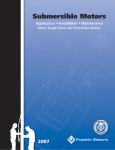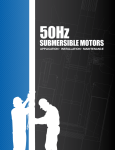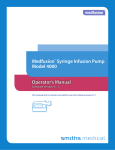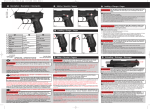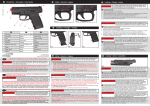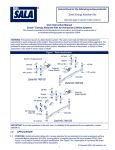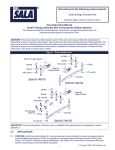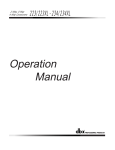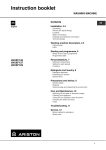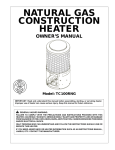Download Franklin Water Pump User's Manual
Transcript
OWNERS MANUAL INSTALLATION • OPERATION • MAINTENANCE 6” & 8” SUBMERSIBLE TURBINE PUMPS BE SURE TO READ OWNER’S MANUAL CAREFULLY BEFORE INSTALLING YOUR PUMP. 6” & 8” SUBMERSIBLE TURBINE PUMPS CONTENTS Inspection-Receipt of Equipment....................................................... Sec. A Equipment and Installation Record................................................. Sec. B General Information........................................................................ Sec. C Suitability of the Well...................................................................... Sec. D Installation-Site & Support Equipment............................................ Sec. E Electrical Installation....................................................................... Sec. F Pump Installation............................................................................ Sec. G Accessories with Installation........................................................... Sec. H Operational Checkup...................................................................... Sec. I Troubleshooting.............................................................................. Sec. J 1 A. INSPECTION-RECEIPT OF EQUIPMENT Examine equipment at the time of receipt. Check that the power cable is not cut or damaged, and that all equipment is correct for the installation. Handle the pump, cable and motor carefully. This is very important because of the precise alignment of the assembly and the vulnerability of the cable. Report any damages or shortages immediately to the freight carrier agent and make notes on the freight bill of lading. This will facilitate a satisfactory and prompt processing of a claim adjustment. B. EQUIPMENT INSTALLATION RECORD *Record the following details at the time of the installation and retain for future references: PUMP DATA________________________________________________________ Manufacturer____________________________________________ Model Number___________________________________________ Serial Number____________________________________________ Date of Installation________________________________________ PUMP SETTINGS____________________________________________________ Well Casing Inside Diameter_________________in. Well Depth_________________ft. length_________________ft. Size of Drop Pipe(Riser)_________________in. Standing Water Level_________________ft. below ground Depth to Lowest Perforation_________________ft.below ground Number of Check Valves_________________ Power Cable Size_________________in. length_________________ft. Length of Air Line_________________ft. MOTOR DATA______________________________________________________ Maunfacturer____________________________________________ Horsepower______________________________________________ Voltage/Phase/Cycle________/_________/_____________________ Full Load Amperage______________________________________ Motor Size______________________________________________ Model__________________________________________________ Serial Number-Date Code__________-________________________ Pump Capacity and Head___________________________________ Installed by______________________________________________ Address_________________________________________________ Phone No_______________________________________________ 2 C. GENERAL INFORMATION The Submersible pump unit comprises a vertical Turbine pump assembly directly-coupled to a Submersible electric motor. The connecting bracket accommodates the coupling between the pump and motor shafts and also serves as the water intake passage. The pump unit is suspended in the well by the riser pipe, and the electric power is taken down from the well head to the motor by the Submersible cable which is secured at intervals to the riser pipe. Please read the manufactures separate instruction manual for the motor, and keep it for future reference. D. SUITABILITY OF THE WELL Submersible Pumps as well as all water pumps, are designed to handle clean, cool, clear water. Water from an undeveloped well often contains excessive amounts of sand, dirt and other abrasives which can cause damage to the pump. Install the pump in a well which has already been properly developed with a test pump. The test pump also provides a means to determine the capacity and setting of the pump to the yield of the well. If the pump removes water at a higher rate than the well produces, the drawdown will be excessive and this will cause the pump to cavitate, resulting in damge to the pump or motor. The well must be deep enough so that the pump suction is at least 10 ft. below the expected drawdown level. The insider diameter of the well casing must be large enough to allow lowering the unit into the well without damage to the “Power Cable”, and the splice between the power cable and the Motor leads. Check that the well is large enough to allow installation of the pump at the required depth. Keep the pump atleast 5 ft. from the bottom, particularly where there is a history of sand in the well. Do not install the pump below the lowest perforations in the well casing unless the well size permits the installation of a shroud over unit to ensure an adequate flow of water over the motor for cooling purposes. The Motor must always be immersed in flowing water. E. INSTALLATIONSITE & SUPPORT EQUIPMENT Equipment & Material Required; The material and equipment necessary for the installation of the pump will vary with the pump size and type of installation. The following list of tools and supplies are offered as a guide. -Materials; Anti-galling lubricant, thread compound, lubricating oil, grease. -Tools & Instruments; Tripod with chain blocks, or rig with power hoist, pipe clamps, megger, pipe wrenches, and mechanical tools. Be sure that the equipment is strong enough to lift the total weight of the pump, riser pipe and water in the riser pipes. When the Power Cable is supplied on a reel, support the reel on a piece of pipe laid across a pair of sturdy saw horses. Locate the reel about six feet from the well so that the cable unwinds from the top. FOUNDATION Construct a concrete foundation which must be RIGID, LEVEL and of adequate STRENGTH to support the complete weight of the pump, motor, column, plus the weight of the water pumping through it without exceeding the permissible bearing pressure for the subsoil. Support the riser pipe at the well head with a well seal, surface plate, or other adapter which seals the well in accordance with local regulations. Make provision for a conduit to carry the power cable into the well. RISER PIPE Make up the riser pipe from random lenghts of threaded and coupled pipe, and make arrangements to secure it at the well by a well seal, surface plate, or other adapter. Use schedule 40 steel pipe for settings less than 600 ft. For deeper settings, use schedule 40 for the bottom 600 ft., and for the remainder use schedule 80. Take great care to keep pipes clean and free from pebbles, scale, and thread chips. Tighten each joint securely. Make sound, airtight connections at all fittings. CHECK VALVES *CAUTION* DO NOT INSTALL THE UNIT WITH THE MOTOR RESTING ON THE BOTTOM, OR CLOSER THAN FIVE FEET FROM THE BOTTOM OF THE WELL. If the pump setting exceeds 100 ft., install a check valve at the first joint in the riser pipe above the pump. For a deep setting pump, a line checkvalve is recommended for every 200 ft. of column pipe. Always use an additional check valve at the surface if the pump is part of a pressure system or if the pressure head exceeds 500 ft. 3 Method #2- Resin Cast Splice *CAUTION* TAKE CARE TO PREVENT DAMAGE TO THE CABLE DURING THE INSTALLATION. F. ELECTRICAL INSTALLATION When the cable is supplied on a reel, support the reel on a piece of pipe laid across a pair of sturdy saw horses. Locate the reel about 6 ft. from the well so that the cable unwinds from the top. Prevent the cable from scraping on the well casing and avoid pinching the cable either in the pipe clamps or between the riser pipe and well casing. SPLICING POWER CABLE TO MOTOR LEADS A waterproof splice must be made to connect the power cable to the motor leads. An improperly made splice will become a service problem. There are different materials and methods that are used to make water tight cable splices. -Examples; by waterproof TAPE splice, RESIN CAST splice, or by HEAT SHRINK splice. Method #1- Taped Splice 1- Remove 10 in. from the outer jackets of the jacketed cable, taking care not to damage the insulation of the individual conductors. 2- Trim the motor leads, so that the yellow wire is 3 in. shorter and the black wire is 3 in. longer than the red one. 3- Trim the wires of the cable so that the yellow wire is 3 in. longer and the black wire is 3 in. shorter that the red one. 4- Strip 1/2 in. of insulation from the end of each wire and scrape the metal clean and thoroughly clean the surface with solvent to insure a watertight splice. 5- Join like-colored wires with connectors and secure connectors with staking pliers. Pull on wires to make sure the wires are firmly crimped. Fill each connector with solder to insure sound mechanical and electrical joints. 6- Bind each connection with approved self-bonding rubber tape, with the first layer extending atleast 1 in. over the insulation, and the second layer extending atleast 1 in. beyond the first. Apply two layers of plastic insulating tape, each extending 1 in. beyond the previous one. Bind the three connectors together with one lapyer of approved self-bonding rubber tape, and two layers of approved electrical tape, all extending over the outer sheath if a Prepare the 3-conductor power cable for splicing, insert a sharp knife blade between the cable jacket and lead insulation and strip the jacket back 2.6” from the end. Strip the cambric wrapping (if any) off of the conductors and strip back rubber insulation 5/8” from the end. Assemble the cable connectors and crimp them in place using a crimping tool. Cut off motor leads to equal length. Clean off ends of the leads for about 12”, using a wet cloth with gasoline or solvent. Clean the end of the power cable also. Insert the three motor leads into corresponding holes in the bottom of the rubber casing and push them several inches out the top. Crimp the motor leads into corresponding connectors, crimping the center one first. Bend the cables into line with the holes in the csing up until the connectors are inside the holes about 1/4” from the top. Mix the resin as directed. Cut off a corner of the bag and squeeze all of the resin into the casing. With the roll of tape on hand, fold the bag, and tape the top of the bag snugly to the power cable until the resin runs out over the top.This will assure maximum coverage of the resin and minimize the size of the finished splice. When the resin is firm to the touch, the splice may be immersed for testing. REPAIR Although cuts and abrasions may not puncture the cable insulation, repair them in the following manner. Use a solvent such as paint thinner or gasoline to clean the cable in the area of damage. Roughen the surface of the insulation with sandpaper and apply a coating of rubber cement to the prepared surface and let dry for 1/2 hour. Cut off a length of 3/4” wide vinyl plastic electrical tape 1” longer than the cut or abrasion, and lay it smoothly over the damage. Start binding the cable with the same tape 1” in front of the damage lapping each wrap halfway over the previous one, until the binding extends 1” beyond the damage. Wind the tape smoothly without wrinkles and avoid stretching it unduly. Add three more layers in a similar manner, each extending 1/2” beyond that beneath. Apply a coating of rubber cement over the repair as an additional bond and to improve the resistance to oil and solvents. WARNING GROUND THE UNIT WHEN TESTING, FAILURE TO GROUND THE UNIT PROPERLY CAN RESULT IN SERIOUS OR FATAL SHOCK. 4 ELECTRICAL INSTALLATION & TESTS Employ a competent electrician to do the wiring in accordance with local electrical codes. Conventional overhead or underground installation is satisfactory for the electrical power transmission to the Well Head. Check that the power supply corresponds with that shown on the name plates of the motor and control box. NOTE; every installation requires a fused disconnect switch or circuit breaker. A SINGLE-PHASE unit includes a control box incorporating overload relays, but require a magnetic starter for automatic operation. A THREE-PHASE unit requires a magnetic starter with three-leg protection having QUICK-TRIP Ambient compensated overload relays. Note; the Warranty is void if incorrect overload relays are used. Mount the control equipment vertically on a post or wall, and protect it from direct sunlight and extremes of temperature. Make the connections to the control equipment in accordance with the wiring diagram to avoid damage to the motor. Preliminary Electrical Test Pump Above Ground After splicing the motor leads to the power cable, use a 500-volt megohm meter (megger) to test the insulation. Connect the ground lead of the megger to the motor frame, and the line leads to the ends of the cable conductors. Turn the crank of the megger for 5 or 10 seconds, and check that the needle shows a value of at least 50 megohms. Remove the megger and wet down the motor leads and power cable with a hose or bucket. Reconnect the megger and check the resistance again. Should the value be appreciably less than before, it indicates damaged insulation. Locate the damage either by visual inspection or by checking the resistance as each successive section of cable are immersed in water. If the cable is new, it is probably unnecessary to check it thoroughly from above the splice down to the motor. G. PUMP INSTALLATION-PERFORMANCE Should the cable get damaged, either cut out the defective length and splice the ends, or repair the damage, as described in the section on cable Repair(F). INSTALLATION Thread the first length of riser pipe into the pump discharge and raise the pump and pipe into a vertical position over the well. Being careful neither to drag the pump along the ground, nor let it strike other objects getting it into place over the well. Lower the pump about 10 ft. into the well and fasten the cable to the riser pipe to prevent tangling and damage. Use electrical tape for light cable and stainless steel bands for heavy cable. Continue to add lengths in the same manner until the required pump setting is reached. Secure the cable to the riser pipe at regular intervals with tape or bands. *CAUTION* TAKE GREAT CARE TO PREVENT DAMAGE TO THE CABLE DURING INSTALLATION. Use an Ohmmeter or megger to make continuity and insulation checks on the cable at intervals of 10 to 20 ft. as the pump is lowered. This will locate any fault in the cable. Where a bleeder type air charging kit is used with a hydro pneumatic tank, install the tee and bleeder valve before adding the last length of riser pipe. This will place the bleeder valve about 20 ft. below the well head. Place the sanitary well seal, surface plate. Or other adapter on the last length of riser pipe and pass the submersible cable through the opening provided. Then attach the discharge tee or elbow to the riser pipe. Lower the riser pipe to its final position and tighten the well seal or other device to support the installation in the well. As soon as the splice joint is submerged in the water, take a resistance reading between the power cable conductors and ground to assure that the insulation and the cable or the splice was not damaged during installation process. Initial Start-up & Performance Check Make final continuity and insulation (0 megohms or higher) checks before connecting the cable to the control equipment. Check that the supply voltage is within10% of the motor rating. It is preferable for the supply voltage to be on the high side. Check all phases of a three-phase supply. Check the pump and well performance before making the final connection to the discharge system. 1- Install a pressure gage and gate valve on the end of the pipe. Close the valve. 2- Start the pump, check the pressure developed against the closed valve. If the pressure is substantially less than expected (don’t forget to allow for the depth to the water level), the pump may be running backward. To change the ratation, refer to the section “Preliminary Electrical Test Pump Above Ground”. 3- Open the gate valve to give a low flow until you are certain that the well will not yield sand. Open the gate valve gradually to give full flow. 4- Use a hook-on ammeter to read the current, which should approximate the full-load current given on the motor nameplate, but must not exceed the service factor rating of the motor. The service factor varies with the make and the horsepower of the motor. Consult the factory if insufficient information is given about Service Factor performance. 5 Check that the currents in the individual phases of a 3-phase system are approximately equal. Where there is considerable difference between them, change all 3 connections at the starter as shown below (so that rotation remains the same) to obtain the most consistent readings. Starter L1 L2 L3 cable (1) cable (2) cable (3) black red yellow yellow black red red yellow black Then subtract the average of the readings from the highest. The difference, expressed as a percent of the average must not exceed 10%. Note that the highest reading must not exceed the maximum permissible for the motor. EXAMPLE: Phase 1 54.0 amp Phase 2 55.0 amp Phase 3 60.0 amp Average: 56.3 amp (a) Install additional riser pipe to place pump lower in the well if possible. (b) Use a cock or similar valve in the discharge line to throttle the pump output to suit the yield of the well. (c) Install FLOATLESS LIQUID LEVEL CONTROL. (d) Use a pressure switch with a low water protection or a separate low-water cutout switch. Neither of these devices give as reliable protection as a floatless liquid level control and both require careful application. (e) Replace the pump with smaller unit to avoid over pumping the well. *CAUTION* NEVER RUN THE PUMP UNLESS IT IS COMPLETELY SUBMERGED IN WATER. Damage can occur to both pump and motor, in addition, air drawn into the pump can cause air-lock. H. ACCESSORIES WITH INSTALLATION LIGHTNING ARRESTERS % Unbalance = 60 - 56.3 x 100 56.3 = 3.7 x 100 = 6.6% 56.3 WARNING FAILURE TO GROUND THE UNIT PROPERLY CAN RESULT IN SERIOUS OR FATAL SHOCK. REFER TO ELECTRICAL CODE REQUIREMENTS. Should the unbalance exceed 10%, ask the power company to improve the voltage balance between the incoming lines. 5- Use a voltmeter to check the voltage at the starter while the pump is running. The average must be within 10% of the motor rating, and the maximum variation of any phase of a 3-phase system for the average should not exceed 1%. 6- Continue to run the pump until the drawdown of the water in the well becomes stable. Should the water level drop to the pump intake to admit air, use one or more of the following methods to protect installation. Install lightning arresters to protect the motor from the effects of electrical storms. Although they will not give protection against direct stirkes they will ground the surges caused in transmission lines by surrounding storms. One arrester is sufficient for a single-phase unit, but two are necessary for a three-phase unit. Install them in accordance with the manufacturers separate instructions, either in the control box on some single-phase systems, or in the supply line immediately ahead of the control equipment. Pay particular attention to the ground connection. DO NOT USE GROUND ROD. Use the best ground on the premises, which is usually the metal riser pipe from the pump or other metal water pipe. RELIEF VALVE Always install a relief valve if the pump is capable of developing pressures in the discharge system greater than the pressure ratings of individual components. The relief valve must be large enough to handle the pump output at the relief pressure. 6 FLOATLESS LIQUID LEVEL CONTROL The sensing elements of a floatless liquid level control consists of 2 electrodes suspended in the well by insulated wires. These wires connect to a relay which serves as a pilot switch to the starting equipment. The lower electode is set just above the pump, and the upper at some distance below the static water level. The device cuts off power to the pump automatically when the water level drops below the lower electrode, and does not restore power until the water level recovers to reach the upper electrode. The Liquid Level Control can also be used as a pilot switch in connection with elevated tanks. J. TROUBLESHOOTING 1. Disconnect power unless required for testing. 2. Have electrical testing done by a qualified electrician. 3. Most problems occur above ground. Remove pump only as a last resort. When troubleshooting or servicing the pump, use all precautions for the voltages involved. PROBLEM POSSIBLE CAUSE REMEDY 1. Electrical trouble Check Power source: starter & reset I. OPERATIONAL CHECKUP The most reliable indication of the condition of a submersible pump are: (a) The current drawn by the motor (b) The insulation resistance of the installation below ground. As the pump wears, the motor current increases, until eventually the overloads trip to protect the motor. While this automatic protection looks after an emergency situation, proper care of a submersible installation should include perioodic check-ups to avoid interruptions in the water supply. Use a megger to check the insulation resistance every six months. Record the insulation resistance and the running current for future reference. When the insulation resistance fall below 10 Megohms, check it frequently for further deterioration and pull the pump when the resistance falls to 1/2 megohm. When pulling the pump, either coil the cable on a reel or raise it from the ground to dry. Check the insulation again when the cable and splices are dry. If the insulation value is between the line and motor casing increases to 50 megohms or more, isolate the fault in the cable or the splice and make the necessary repairs. However, if the insulation reading remains low, disconnect the motor from the cable and check the motor separately. Should the motor be defective, check the pump end for wear and obtain a replacement for either the motor alone, or the pump unit, as necessary. WARNING Check resistance: cable and motor Unit fails to start Pump fails to deliver water Reduced pump output Overload trips Unit cycles too frequently Call Dealer or Electrician 2. Pump Sandlocked Call Dealer: pull pump and clean 1. Insufficient well yield: water level has dropped. Reset pump lower into well 2. Clogged intake screen Pull pump 3. Air Lock in pump Start and stop pump several times and allow 1 min. between 4. Leak in discharge Raise pipe until leak is found. 1. Screen or pump partly plugged Pull pump and clean 2. Insufficient well yield Check water level: lower pump if permissible. 3. Worn pump - excessive wear due to abrasives. Replace worn parts 4. Low voltage Call Electrician 5. Three Phase unit running backward Reverse rotation 1. Worn pump or pump bound by sand Pull pump and clean or replace worn parts. 2. Electrical trouble Call Dealer or Electrician 1. Pressure switch out of adjustment Readjust to correct setting or replace Restrict flow to yield 2. Leaks in service line Locate and correct 3. Check valve leaking Replace 4. Water logged tank Check tank for leaks be sure fittings are functioning properly. HAZARDOUS VOLTAGE- CAN SHOCK, BURN, OR EVEN KILL. 7 U.S. LIMITED WARRANTY* Franklin Pump Systems, Inc. Franklin Pump Systems, Inc. warrants its new products to be free of defects in material and workmanship for a period of 1 year from date of installation or 2 years from date of manufacture, whichever comes first, WHEN installed in a domestic water systems application and pumping potable water only. Warranty does not cover applications pumping saltwater or other corrosive liquids. Consult and adhere to local codes for all applications. Franklin Pump Systems, Inc. also provides additional warranty coverage on specific products as specified herein. Franklin Pump System’s warranty obligation with regard to equipment not of its own manufacture is limited to the warranty actually extended to Franklin Pump System by its suppliers. This warranty extends only to the original retail purchaser and only during the time in which the original retail purchaser occupies the site where the product was originally installed. Requests for service under this warranty shall be made by contacting the installing Franklin Pump System dealer (point of purchase) as soon as possible after the discovery of any alleged defect. Franklin Pump System will subsequently take corrective action as promptly as reasonably possible. Franklin Pump System at its discretion may replace or repair any product that fails under this warranty after inspection by an authorized company representative or after Franklin Pump System has received the product at our factory. Replacement or repair cannot be made until after the product is inspected. All charges or expenses for freight to and from the factory, removal and reinstallation of the product, or installation of a replacement product are the responsibility of the purchaser. THIS WARRANTY SUPERSEDES ANY WARRANTY NOT DATED OR BEARING AN EARLIER DATE. ANY IMPLIED WARRANTIES WHICH THE PURCHASER MAY HAVE, INCLUDING MERCHANT ABILITY AND FITNESS FOR A PARTICULAR PURPOSE, SHALL NOT EXTEND BEYOND THE APPLICABLE WARRANTY PERIOD. Some states do not allow limitations on how long an implied warranty lasts, so the above limitation may not apply to you. IN NO EVENT SHALL FRANKLIN PUMP SYSTEM BE LIABLE FOR INCIDENTAL OR CONSEQUENTIAL DAMAGES. Some states do not allow the exclusion or limitation of incidental or consequential damages, so the above may not apply to you. This warranty does not apply to any product which has been subjected to negligence, alteration, accident, abuse, misuse, improper installation, vandalism, civil disturbances, or acts of God. The only warranties authorized by Franklin Pump System are those set forth herein. Franklin Pump System does not authorize other persons to extend any warranties with respect to its products, nor will Franklin Pump System assume liability for any unauthorized warranties made in connection with the sale of its products. THIS WARRANTY GIVES YOU SPECIFIC LEGAL RIGHTS, AND YOU MAY ALSO HAVE OTHERRIGHTS WHICH MAY VARY FROM STATE TO STATE. * Contact Franklin Pump Systems, Inc. Export Division for International Warranty. 12401 Interstate 30 • P.O. Box 8903 Little Rock, AR 72219 12401 Interstate 30 • P.O. Box 8903 Little Rock, AR 72219 E-631 5/05













